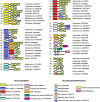Deciphering how Cpl-7 cell wall-binding repeats recognize the bacterial peptidoglycan
- PMID: 29184076
- PMCID: PMC5705596
- DOI: 10.1038/s41598-017-16392-4
Deciphering how Cpl-7 cell wall-binding repeats recognize the bacterial peptidoglycan
Abstract
Endolysins, the cell wall lytic enzymes encoded by bacteriophages to release the phage progeny, are among the top alternatives to fight against multiresistant pathogenic bacteria; one of the current biggest challenges to global health. Their narrow range of susceptible bacteria relies, primarily, on targeting specific cell-wall receptors through specialized modules. The cell wall-binding domain of Cpl-7 endolysin, made of three CW_7 repeats, accounts for its extended-range of substrates. Using as model system the cell wall-binding domain of Cpl-7, here we describe the molecular basis for the bacterial cell wall recognition by the CW_7 motif, which is widely represented in sequences of cell wall hydrolases. We report the crystal and solution structure of the full-length domain, identify N-acetyl-D-glucosaminyl-(β1,4)-N-acetylmuramyl-L-alanyl-D-isoglutamine (GMDP) as the peptidoglycan (PG) target recognized by the CW_7 motifs, and characterize feasible GMDP-CW_7 contacts. Our data suggest that Cpl-7 cell wall-binding domain might simultaneously bind to three PG chains, and also highlight the potential use of CW_7-containing lysins as novel anti-infectives.
Conflict of interest statement
The authors declare that they have no competing interests.
Figures









Similar articles
-
A novel type of peptidoglycan-binding domain highly specific for amidated D-Asp cross-bridge, identified in Lactobacillus casei bacteriophage endolysins.J Biol Chem. 2013 Jul 12;288(28):20416-26. doi: 10.1074/jbc.M112.446344. Epub 2013 Jun 3. J Biol Chem. 2013. PMID: 23733182 Free PMC article.
-
Structural Basis for Cell-Wall Recognition by Bacteriophage PBC5 Endolysin.Structure. 2019 Sep 3;27(9):1355-1365.e4. doi: 10.1016/j.str.2019.07.001. Epub 2019 Jul 25. Structure. 2019. PMID: 31353242
-
Thermal stability of Cpl-7 endolysin from the streptococcus pneumoniae bacteriophage Cp-7; cell wall-targeting of its CW_7 motifs.PLoS One. 2012;7(10):e46654. doi: 10.1371/journal.pone.0046654. Epub 2012 Oct 8. PLoS One. 2012. PMID: 23056389 Free PMC article.
-
Bacteriophage and peptidoglycan degrading enzymes with antimicrobial applications.Recent Pat Biotechnol. 2007;1(2):113-22. doi: 10.2174/187220807780809463. Recent Pat Biotechnol. 2007. PMID: 19075835 Review.
-
Bacteriophage endolysins as a novel class of antibacterial agents.Exp Biol Med (Maywood). 2006 Apr;231(4):366-77. doi: 10.1177/153537020623100402. Exp Biol Med (Maywood). 2006. PMID: 16565432 Review.
Cited by
-
Endolysins against Streptococci as an antibiotic alternative.Front Microbiol. 2022 Aug 2;13:935145. doi: 10.3389/fmicb.2022.935145. eCollection 2022. Front Microbiol. 2022. PMID: 35983327 Free PMC article. Review.
-
Microarray Strategies for Exploring Bacterial Surface Glycans and Their Interactions With Glycan-Binding Proteins.Front Microbiol. 2020 Jan 10;10:2909. doi: 10.3389/fmicb.2019.02909. eCollection 2019. Front Microbiol. 2020. PMID: 32010066 Free PMC article. Review.
-
Structural basis for recognition of bacterial cell wall teichoic acid by pseudo-symmetric SH3b-like repeats of a viral peptidoglycan hydrolase.Chem Sci. 2020 Oct 23;12(2):576-589. doi: 10.1039/d0sc04394j. Chem Sci. 2020. PMID: 34163788 Free PMC article.
-
A New Phage Lysin Isolated from the Oral Microbiome Targeting Streptococcus pneumoniae.Pharmaceuticals (Basel). 2020 Dec 19;13(12):478. doi: 10.3390/ph13120478. Pharmaceuticals (Basel). 2020. PMID: 33352708 Free PMC article.
-
Phage Lysins for Fighting Bacterial Respiratory Infections: A New Generation of Antimicrobials.Front Immunol. 2018 Oct 16;9:2252. doi: 10.3389/fimmu.2018.02252. eCollection 2018. Front Immunol. 2018. PMID: 30459750 Free PMC article. Review.
References
-
- Borysowski, J. & Górski, A. Anti-staphylococcal lytic enzymes. In: Enzybiotics: Antibiotic Enzymes as Drugs and Therapeutics. pp. 149–172 Villa, T. G., Veiga-Crespo, P, editors, John Wiley & Sons, Inc., Hoboken, NJ, USA. (2010).
Publication types
MeSH terms
Substances
LinkOut - more resources
Full Text Sources
Other Literature Sources

